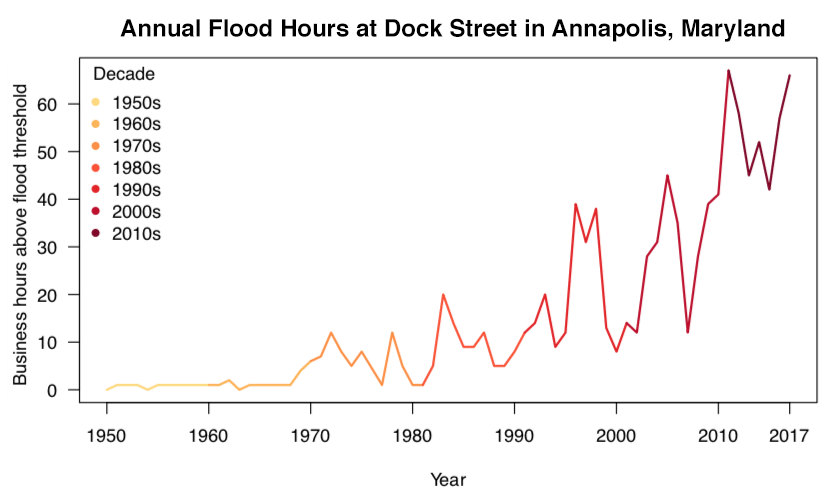| Above: High tide flooding on Dock Street in Annapolis, Maryland. Image credit: Alex Davies and Luis Rodriguez. |
How can parking meter records and tweets from local businesses be used for climate science research? By documenting the economic impact of the high tide on local economic activity, explained Stanford researcher Miyuki Hino in the paper, “High-tide flooding disrupts local economic activity”, published Friday in the journal Science Advances. Even a small economic hit by national standards can be devastating on a local level. This study gives us a glimpse of the impacts and adaptations that will be playing out in hundreds of locations big and small across the United States as sea level rise and other climate-change impacts take their toll.
Hino and colleagues studied the impact of the increased frequency of high tide flooding due to sea level rise on businesses in the Dock Street neighborhood in Annapolis, Maryland, home to the U.S. Naval Academy. According to NOAA, Annapolis and nearby Baltimore top the list of cities experiencing increases in high-tide flooding, with over a 920% increase since 1960. In the early 1960s, Annapolis had about four high-tide flooding days a year. In 2017, the small city on Chesapeake Bay experienced 63 high-tide flooding days.
 |
| Figure 1. Annual number of hours flooding was observed on Dock Street in Annapollis, Maryland between 1950 and 2017. Image credit: Miyuki Hino. |
Little is known about the social and economic consequences of these events, since these high-tide floods, also called nuisance or sunny-day floods, typically last for just a few hours at a time and rarely leave lasting damage. To document the occurrence of these floods, the researchers used tide gauge data in combination with satellite and photographic evidence of the flooding. An important source of these photographs were tweets from local businesses. When periods of flooding were identified, receipts from the parking lot flooded by the ocean were studied to determine by how much visits to the Dock Street area were affected. During the period May 2016 - November 2017, 4584 hours of parking meter records were reviewed. They revealed that when the parking lot flooded, people did not go to nearby unflooded parking areas--they simply avoided coming downtown, resulting in a loss of revenue for local businesses. Even after the flooding ended, there was a more than six-hour lag until visitation returned to its usual levels.
Over the course of a year, the Dock Street area experienced 63 days with high tide flooding, and 65 - 70 hours when the parking lot was flooded. This resulted in a 2% loss of visits (3000 lost visits) to the historic downtown district, at a cost of $86,000 - $176,000 per year. With three and 12 inches of additional sea level rise, the researchers estimated that high-tide floods would reduce visits by 4% and 24%, respectively, which would amount to additional losses in the hundreds of thousands of dollars per year. However, the city is looking at adaptation measures—potentially installing pumps to help keep the parking lot dry, or installing new walkways that improve access to businesses during flood periods.
Related cat6 posts:
Retreat From a Rising Sea: A Book Review, our February 2018 post.
Sea Level Rise is Accelerating, Says Unnerving New Research, our February 2018 post.
Our December 2017 review of Jeff Goodell’s must-read book on sea level rise, The Water Will Come: Rising Seas, Sinking Cities, and the Remaking of the Civilized World.
Why Is It So Hard to Fix the National Flood Insurance Program?, our November 2017 post.
Blockbuster Assessment: Humans Likely Responsible For Virtually All Global Warming Since 1950s, our November 2017 post detailing the U.S. government’s official science findings on sea level rise.
Also, see weather.com’s powerful 2017 report on Naval Station Norfolk (Virginia), a massive base that now experiences routine floods at high tide. Naval Station Norfolk could eventually flood on 200 days a year, based on current trends.
Have a great weekend, everyone!


